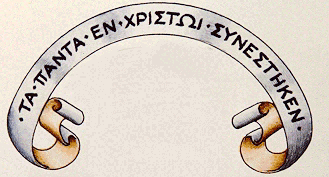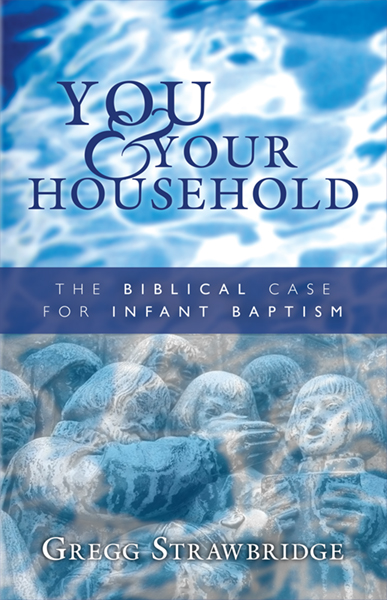Not far from our home in Hamilton, Ontario, Canada, is one of southern Ontario’s premier universities, McMaster, known internationally as a centre for advanced scientific and medical research. What few remember is that the university once had a connection with the Baptist Convention of Ontario and Québec, the only remnant of which is the presence on campus of McMaster Divinity College, whose most famous faculty member was probably the late Clark Pinnock.
During my first years of teaching at a neighbouring institution, I often found myself in the Mills Library at McMaster. During one visit, I happened to notice the university’s crest outside the elevators, and I was surprised to read the motto emblazoned in Greek letters above the shield: ΤΑ ΠΑΝΤΑ ΕΝ ΧΡΙΣΤΩΙ ΣΥΝΕΣΤΗΚΕΝ: “In Christ all things hold together.” This, of course, is a reference to Colossians 1:17. I imagined that hundreds of people would walk past this coat of arms every day as they moved between the floors of the library, unaware of what the words meant or of their history. According to the university’s website, “One may suppose that the motto and book were intended to express the concept, espoused in the Will of Senator McMaster, of ‘a Christian school of learning’.”
Some months ago, I came across a scanned copy of an issue of The Silhouette, the student newspaper, dated 20 September 1957. The headline reads: BAPTIST TIE IS BROKEN, followed by “Gilmour sees little change in campus atmosphere, work.” Dr. George P. Gilmour was president of the university at the time the Ontario Legislature approved the requested changes to its status.

The article hints at the motivation for the move:
Dr. Gilmour pointed out that this break with the Baptists “will make relatively little change in the atmosphere and the work of the university as far as the students are concerned. But,” he added, “it is extremely important from the point of view of public relations and community support.”
Historically, it has been difficult for universities established on an explicitly Christian basis to maintain their religious identity over the long term. The list of universities that began their existence under the auspices of the church, only to relinquish that connection much later, is a long one. The university itself started as an institution closely connected to the monasteries in mediaeval Europe. In the United States, Harvard began as a Puritan institution in 1636. Yale followed in 1701, founded at least in part in response to secularizing trends at Harvard. Princeton was started in 1746 by Reformed Christians, with its religious character lasting into the 20th century but not much beyond the first decade. I could go on, but, as I said, the list is long.
One possible reason for a university losing its confessional moorings is an underlying worldview which divides the curriculum between divinity/theology on the one hand and so-called secular disciplines on the other, parallel to the historic scholastic division between sacred and secular. Because it was assumed that these latter disciplines were subject to the canons of a neutral reason, any connection with the faith would be extrinsic at least and unnecessary at most. In McMaster’s case, this is undoubtedly why the university could so easily restrict the historic Baptist element to the Divinity College, still situated uneasily on campus as a curious vestige of its earlier affiliation.

A connection with the institutional church, even if maintained, was no guarantee that the subjects taught at the school would be approached from an integrally Christian perspective. Once more, I could rattle off a litany of universities that remain under the auspices of mainline protestant denominations but where an effort to think Christianly beyond the bounds of theology is foreign to its educational mission and has been for a long time. At the same time, the lack of a church connection is by no means a hindrance to a university maintaining a Christian identity, as seen at an institution of higher education in my hometown.
Why do faith-based universities stray from their founding mission? Each case is undoubtedly different, but it may be simply because those leading it have ceased to believe that the faith is important or relevant to what a university does. Even Abraham Kuyper’s Free University of Amsterdam, founded in 1880 as an institution rooted in the Dutch religious awakening of the late 19th century, began to follow the path of the secular universities not quite half a century after Kuyper’s death in 1920. Having the “correct” understanding of the relationship between faith and learning is no guarantee that an institution will remain faithful. Nor will providing in one’s will for “a Christian school of learning” protect its identity where the faithful themselves have abandoned the faith.
Yet many Christian universities have succeeded in staying the course over the decades. We would do well to examine these carefully to see what they have done to this end. There are undoubtedly lessons to be learnt with respect to hiring procedures, board governance, departments’ relationship to the academic administration, vision drift, and so forth. But perhaps the greatest factor is an institutional commitment, backed by a committed support community, to keep its vision focussed on the person of Jesus Christ and his coming kingdom.
















